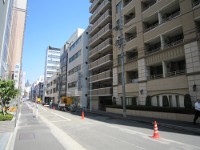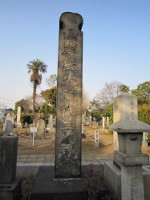 Speaking of March, it was 3.11 Great East Japan Earthquake three years ago, but it is an unacceptable disaster for Tokyo people to forget the 3.10 Tokyo Air Raid, which killed 100,000 people 69 years ago. At this time, among those who evacuated to Meijiza in Hamacho and lost their lives, there is the name of Kayo Yamagishi (1876-1945), a novelist, play critic, and calligrapher born in Nihonbashi.
Speaking of March, it was 3.11 Great East Japan Earthquake three years ago, but it is an unacceptable disaster for Tokyo people to forget the 3.10 Tokyo Air Raid, which killed 100,000 people 69 years ago. At this time, among those who evacuated to Meijiza in Hamacho and lost their lives, there is the name of Kayo Yamagishi (1876-1945), a novelist, play critic, and calligrapher born in Nihonbashi.
Kayo Yamagishi was born in the real name Sojiro, the main street Honcho-dori St. at the time, and Kagaya (commonly known as Kagayoshi), a glass and eyeglass wholesaler in Toyu-cho (currently Nihonbashiodenmacho). Cultural figures who grew up in the same town include Seitan Kawajiri and Shigure Hasegawa. According to the time rain, "Old Mon Nihonbashi", her father gave a speech to celebrate the publication of the Constitution at the Oten Kagayoshi.
He excelled in Japanese calligraphy from an early age, and was called a prodigy under the calligrapher Ichiroku Iwaya, and later became a family with the Kaganoya-ryu.) He entered Inkuriyusha with the introduction of his 16 son Konami, and became a novelist under Koyo Ozaki. His work depicting the downtown atmosphere set in Nihonbashi merchants and Hanayanagi world in the Meiji era, including his masterpiece "Kon Japanese shop curtain", was called "Nihonbashi Literature". In the later years, he became interested in theater, contributing to the popularization of Western drama, such as performing a play of translation of leaves at Meijiza by Otojiro Kawakami, and also played a role in Kabuki's play reviews. His personality is friendly and fashionable, and is said to have been loved by everyone. The painter Kiyokata Kaburagi was a friend who forgives each other.
 In the Great Air Raid on March 10, 1945, he evacuated to a Meijiza building close to his home and had a connection with performing a translation drama, but he was also damaged and died. Kayo Yamagishi, the last writer of inkstone Tomosha, was born and raised in Nihonbashi, depicting Nihonbashi, and ending his life in Nihonbashi. I was 69 years old.
In the Great Air Raid on March 10, 1945, he evacuated to a Meijiza building close to his home and had a connection with performing a translation drama, but he was also damaged and died. Kayo Yamagishi, the last writer of inkstone Tomosha, was born and raised in Nihonbashi, depicting Nihonbashi, and ending his life in Nihonbashi. I was 69 years old.
[On the photo] At present, Odenma Honcho-dori St. in the former Totsuyu town. Until the train ran on Kokumachi-dori (now Edo-dori St.), this was the main road, and there were large shops. In the Edo period, the Shoshi and Koshodo of Juzaburo Tsutaya was also here.
[Lower photo] The tomb of the Yamagishi family in Yanaka Cemetery. An inscription of a postcard is engraved on the statue pedestal of Otojiro Kawakami nearby.

